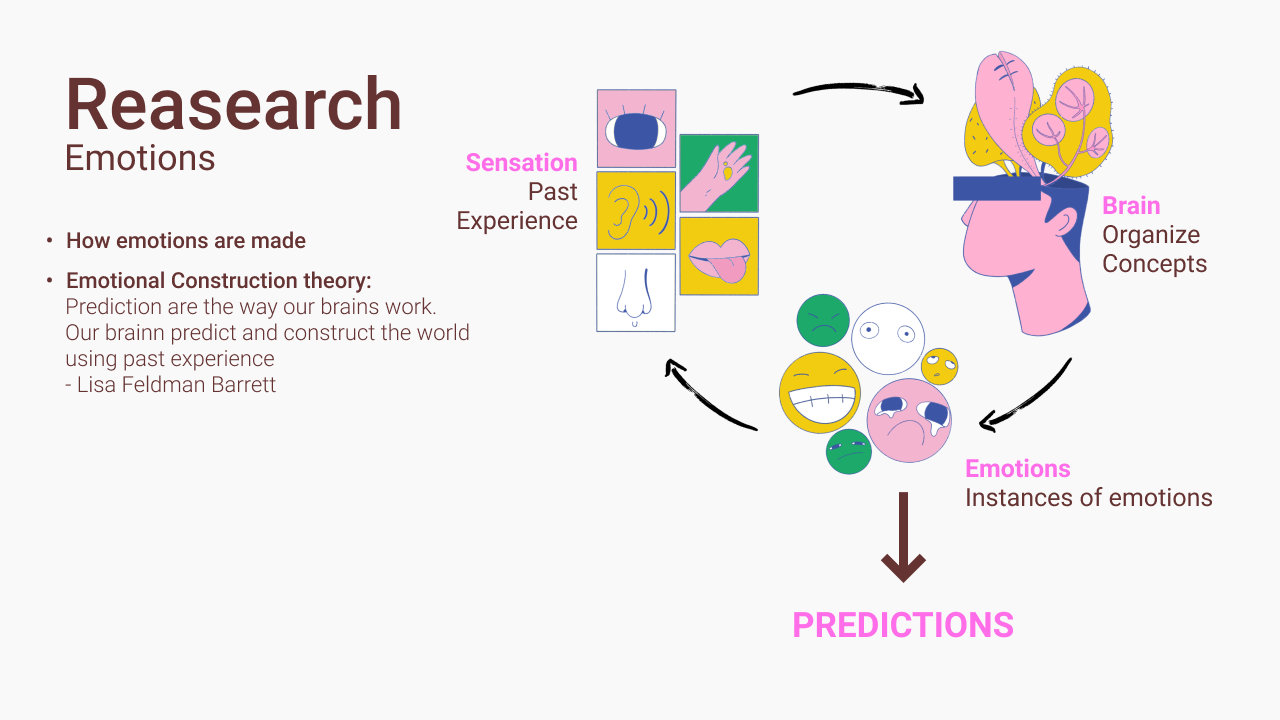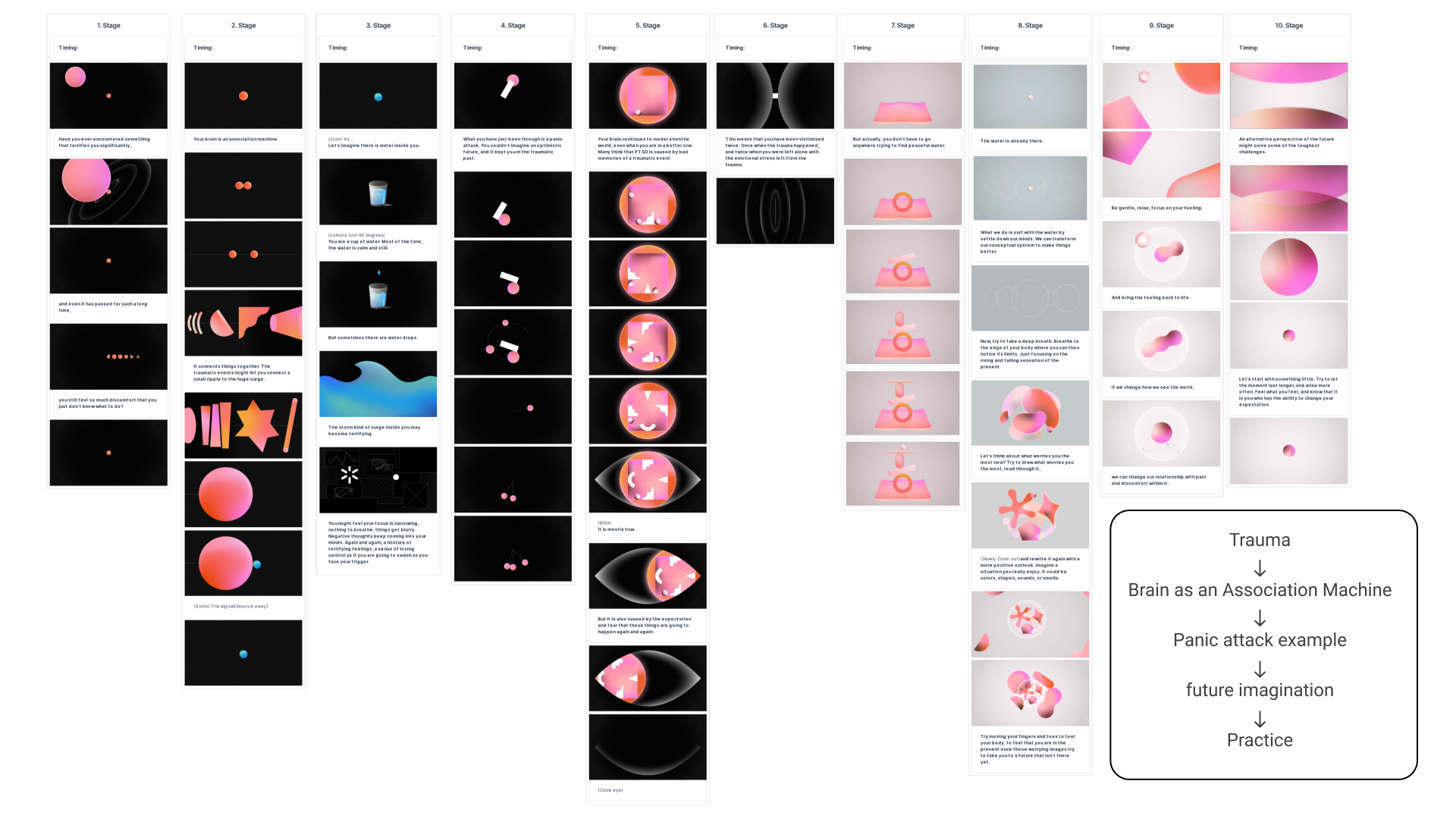COPE
Director | Taylor Su
Storyboard | Taylor Su
Motion Desgin | Taylor Su
Animation Music | B. Shichi Liu
Narrator | Sarah Blades
Advisors | John Roach, Barbara Morris, Aya Karpińska, Louisa Campbell
Special Thanks | Dae Young Kim, Mia Meus, Molly Burke,
Adam Brown, Andrew Shea, Valerie Lin
COPE aims to help people with PTSD to live with their mental condition, and raise people's awareness of PTSD. The form of this project includes an animation and a toolkit. The animation provides a future scenario where the audience can feel safe and thrive. The toolkit is a one-day diary for a person with PTSD that invites readers to interact with the toolkit, knowing that they are not alone, and they can get better.
![]()

Animation
The animation was inspired by the future imagination research worked by Adam Brown, who teaches psychology at The New School. Throughout the design process, I was able to get insights from him and the Trauma and Global Mental Health Lab.
“Future imagination” refers to our predictions toward the things that lay ahead. The study found that people with PTSD are more trauma-focused when imagining their future. The reason is that many people think that PTSD is caused by bad memories, which is mostly true. However, it is also caused by the expectation that these bad things are going to happen again and again.
What if we can show them a safe future and give them an experience of living in a future scenario where they feel confident and safe? That might be enough to help them recover from PTSD without even dealing with the traumatic memories.
The animation was inspired by the future imagination research worked by Adam Brown, who teaches psychology at The New School. Throughout the design process, I was able to get insights from him and the Trauma and Global Mental Health Lab.
“Future imagination” refers to our predictions toward the things that lay ahead. The study found that people with PTSD are more trauma-focused when imagining their future. The reason is that many people think that PTSD is caused by bad memories, which is mostly true. However, it is also caused by the expectation that these bad things are going to happen again and again.
What if we can show them a safe future and give them an experience of living in a future scenario where they feel confident and safe? That might be enough to help them recover from PTSD without even dealing with the traumatic memories.



The Reasearch of the project started with a theory called Emotional construction theory by Dr. Lisa Feldman Barrett. Dr. Lisa’s theory promotes that our brains work through making predictions. It means our brains construct the world using past experiences to create the understanding of the current one.
“Predictions help us to make sense to the world in an efficient way. Our brains don’t react to the world. Our brains predict and construct the world using past experiences.” - Dr. Lisa Feldman Barrett
I found this theory fascinating and wondering if I can help traumatized people to deal with the potential triggers by transforming their prediction towards the trigger.
I had an interview with Adam Brown, who is the Professor of Psychology in The New School, I was really inspired by his research about future imagination. According to Adam research, future imagings are more trauma-focused for people with PTSD. And that means PTSD was not only because of what happened in the past, but also caused by the expectation that these bad things are going to happen again and again.
And here is what I thought: what if we can give these people an experience of living in a future scenario where they can feel confident and safe, that might be enough to help them recover from PTSD without even dealing with the traumatic memories.
After all the research, I started to work on the story of the animation.
I wanted this animation to be geared towards general public audience rather than focusing on a very specific type of trauma such as soldiers or women with sesxual harrassment experiences. I wanted this animation to be something that people can easily approach, understand, and maybe start to want to know more about PTSD, kinda like a place for people to open the conversation.
“Predictions help us to make sense to the world in an efficient way. Our brains don’t react to the world. Our brains predict and construct the world using past experiences.” - Dr. Lisa Feldman Barrett
I found this theory fascinating and wondering if I can help traumatized people to deal with the potential triggers by transforming their prediction towards the trigger.
I had an interview with Adam Brown, who is the Professor of Psychology in The New School, I was really inspired by his research about future imagination. According to Adam research, future imagings are more trauma-focused for people with PTSD. And that means PTSD was not only because of what happened in the past, but also caused by the expectation that these bad things are going to happen again and again.
And here is what I thought: what if we can give these people an experience of living in a future scenario where they can feel confident and safe, that might be enough to help them recover from PTSD without even dealing with the traumatic memories.
After all the research, I started to work on the story of the animation.
I wanted this animation to be geared towards general public audience rather than focusing on a very specific type of trauma such as soldiers or women with sesxual harrassment experiences. I wanted this animation to be something that people can easily approach, understand, and maybe start to want to know more about PTSD, kinda like a place for people to open the conversation.

Trigger
“Control”, “Transparency”, “Prediction”, these are the three key elements that can help people with PTSD to feel safe. Control means to let the patient know that he always has the control to pause, or leave the current situation. Transparency means the operations and decisions are conducted with transparency to build and maintain trust. And prediction means to make things as predictable as possible, to make the patient feel safe.
Everything can be a trigger to someone. It is okay to feel not okay. And it is okay to ask for help. So if you feel triggered, uncomfortable, or need any support:
>> ISTSS
>> FIND A CLINICIAN
>> GETTING HELP

Future Study / Looking for Collaboration
In the future I will focus on the posibility of creative art therapy to help children who don’t have tools to verbalize their trauma. I am currently looking for collaborators.
So let’s get in touch!
Contact: suw150@newschool.edu
In the future I will focus on the posibility of creative art therapy to help children who don’t have tools to verbalize their trauma. I am currently looking for collaborators.
So let’s get in touch!
Contact: suw150@newschool.edu


